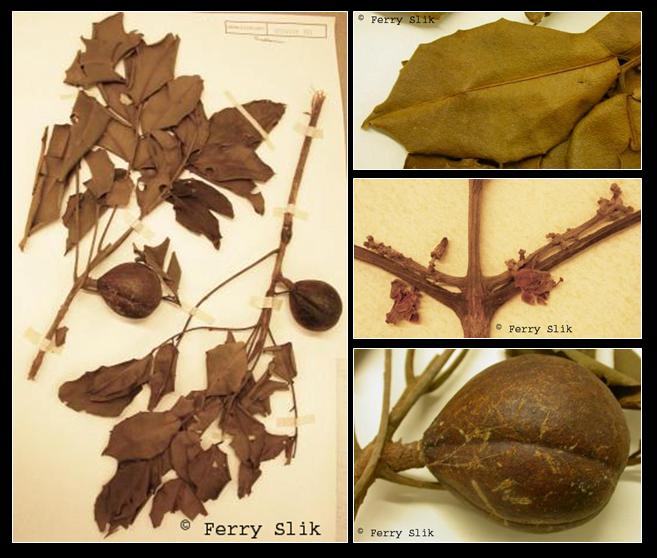Dysoxylum acutangulum Miq., Fl. Ind. Bat. Suppl. (1861)
Latin for 'sharply angular'.Synonyms
Alliaria acutangula (Miq.) Kuntze
Alliaria schultzii (C.DC.) Kuntze
Dysoxylum foveolatum Radlk.
Dysoxylum schultzii C.DC.
Diagnostics
Upper canopy tree up to 47 m tall and 140 cm dbh. Stipules absent. Leaves
alternate, compound, leaflets penni-veined but venation barely visible,
glabrous. Flowers ca. 10 mm diameter, white, placed in racemes. Fruits ca. 48 mm
diameter, yellow-orange, capsules. Seeds with small orange arilloid.
Description
Tree to 47 m tall; bole to 140 cm diam., fluted and clear to 18 m; buttresses to 3 m
tall and 2 m out. Bark smooth, yellowish, with conspicuous lenticels, becoming irregularly
cracked and shedding large scales; inner bark yellowish or orangish fawn, somewhat
speckled and with groups of conspicuously thickened cells; wood orange-brown,
hard. Leafy twigs c. 6 mm diam. with conspicuous cicatrices and lenticels; apical buds
stiletto-like with minute fulvous tomentum. Leaves 15-30(-40) cm, 2-6(-7)-jugate,
paripinnate with minute apical spike or its scar, glabrous to minutely puberulous, +/- decussate;
petiole 8-11 cm long, 3-4 mm diam., adaxially grooved and angled when
dried, base somewhat swollen; rachis grooved and angled when dried. Largest leaflets
the most distal, 9-15 by 5-6.5 cm. elliptic, coriaceous, in life minutely pellucid-punctate,
minutely rugulose when dried, subopposite, bases acute, +/- asymmetric,
apices acute to acuminate, costae c. 14-16 on each side, rather obscure, spreading,
sometimes with domatia in their axils; petiolules 5-8(-10) mm, scarcely swollen.
Thyrses 3-8 cm, narrow, axillary to subramillorous; axes pubescent, bearing fascicles
of 1 to a few hyacynth-scented flowers; bracts c. 0.5 mm, densely pubescent;
pedicels 0-1 mm. Calyx c. 2.5 mm diam., very shallowly crateriform, confluent
with pseudopedicel c. 1 mm long, sparsely shortly pubescent without, margin +/- 4-lobed.
Petals 4, c. 12-13 mm long, oblong, +/- puberulous on both sides, yellow or creamy
yellow, apices acute. Staminal tube sometimes sparsely pubescent without, glabrous
within, margin crenulate; anthers 8(-10), c. 1 mm long, ovate to elliptic, weakly exserted.
Disk c. 1.5 mm tall, shallowly cupuliform, fleshy, glabrous or sometimes pubescent
within, red. Ovary densely pubescent (3- or) 4-locular, each locule with 2 collateral
ovules; style pubescent in proximal half; stylehead subdiscoid. Capsule 5-8 cm
diam., subglobose to pyriform, (3- or) 4-valved, glabrous, orange; pericarp to 1 cm
thick, heavily veined when old, latex white. Seeds (3)-4, sometimes some aborted, c. 2
cm long, ellipsoid, black with small orange arilloid hilum on one side; cotyledons green.
[from Flora Malesiana]
Ecology
In undisturbed mixed dipterocarp forests up to 1000 m altitude. On hillsides
and ridges with sandy soils. In Australia usually found in gullies.
Uses
Membalo is perhaps traditionally the most important native meliaceous timber
tree and was formerly much exported from Bangka to Java. The wood of the bole
and particularly the buttresses is beautifully marked but difficult to work:
it has been largely used for furniture but also beams, cartwheels and coffins. The seeds
are said to be poisonous and contain dysoxylum acid.
Distribution
Peninsular Thailand to New Guinea, the Solomon Islands and Australia.
Local names
Aru Islands: Ngersaweran.
Borneo: Langkang.
Sumatra: Ambalo, Ambalun, Membalo.
